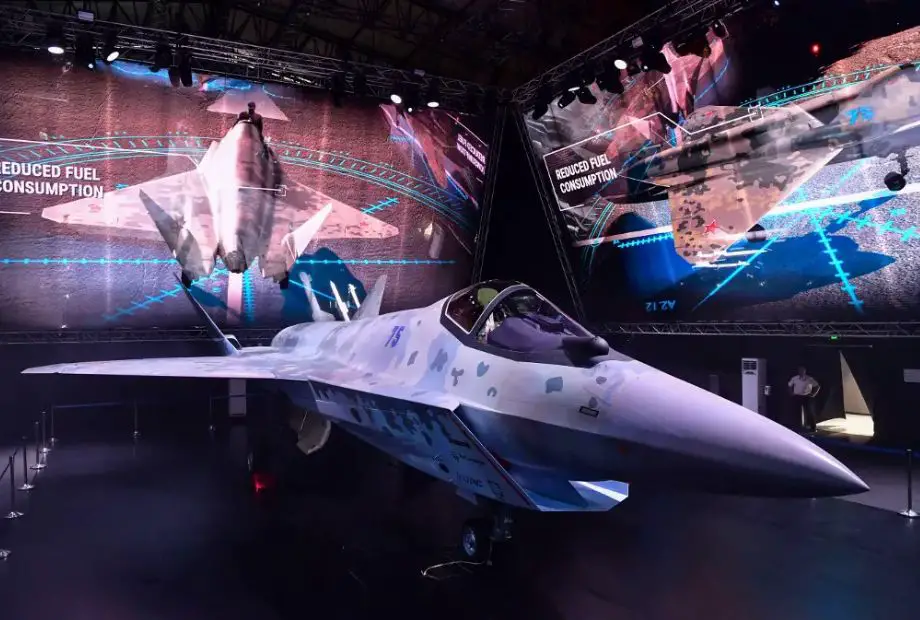Analysis: What to expect from world cheapest stealth fighter Sukhoi-75 checkmate
Few statements are as likely to explode the online comment section as "the F-35 is a billion-dollar aircraft that can't engage in air combat" and "the Su-57 is not a fifth-generation fighter." The Russian Sukhoi Su-75 has the same potential to spark heated debate. But in a world where America is considering retiring its oldest fifth-generation fighters and is preparing to test-fly its sixth-generation fighters, Russia is still talking about producing a low-end fifth-generation fighter by the end of the decade.
Follow Army Recognition on Google News at this link

Su-75 presented at MAKS-2021 air show (Picture source sputnik news )
Much of what is known about the Su-75 comes from the spectacular releases of the Russian company behind it - Rostec. But for now, the aircraft remains in the project stage, and it's difficult to see where the funds will come from to develop it.
A Worthy Successor to the MiG-21
If the Su-75 were ever produced as advertised, it would be an interesting, less expensive, yet still capable aircraft for countries with constrained budgets. It's presented as a fifth-generation fighter with stealth features, notably at the front. It would be a worthy stealth successor (or at least to some extent) to the fleets of MiG-21s around the world.
RIA indicated that the initial price would be around $30 million, which is much, much cheaper than most American and European combat aircraft on the market. Rostec has stated that 300 units would be produced over the next 15 years. According to Defense Express, "Basically, it's a MiG-21 with improved stealth, digital systems, and precision-guided weapons integrated into its kit."
An Appeal for International Funding
While many aircraft are developed under highly secretive conditions, like the American sixth-generation NGAD fighter, the Russian Su-57, and the Chinese Shenyang FC-31, the same cannot be said for the Russian Sukhoi Su-75. The Su-75 appears at military shows with spectacular promotional videos in a dramatic manner.
However, many outside observers are not impressed with the Su-75. It is believed that what is displayed at military exhibitions is an elaborate mock-up. It's a low-end fifth-generation fighter concept designed to be affordable for countries that can't buy high-end fifth-generation American fighters (or are otherwise banned by the US from buying them). As YouTuber Perun, a renowned defense economics specialist, states, "... this is not an export product, not yet, it's a program to create one."
Outside notes that the Russian company behind the project, Rostec, lacks funding from the Russian government to develop it. Instead, the company is forced to make spectacular promotional videos and take its mock-up (unveiled with spectacular lighting) to generate interest and persuade other countries to invest in the idea to make it a reality.
Another reputable YouTube channel, Binkov's Battlefields, notes that the Su-75 is an exciting idea. If it could get the investments it needs, it could become a decisive aircraft for countries unable to purchase F-35s and others. They also note that the Su-75 Checkmate already had a foreign buyer. But most importantly, this video was made over two years ago - before the large-scale Russian invasion of Ukraine, and for the Russian defense industry, it was a completely different time.
Despite this, Rostec claims that development is progressing and that "... production of the first samples has begun" and that the Su-75 is in pre-production. According to Interfax, the initial flight of the aircraft was planned for 2023, then for 2024, with initial deliveries between 2026 and 2027. But this seems incredibly fast and extremely unlikely.
The Russian Su-57 made its first flight in 2010, and although it is currently being produced at a low rate, it has still not been seen in combat 14 years after its first flight. The Checkmate hasn't even flown yet. The National Interest reported in February 2024 that its first flight could still be years away. Rand states that optimistic projections regarding the Su-75 seem highly questionable - especially given the enormous challenges Russia has faced in developing the Su-57 (which, according to them, probably won't be fully operational until 2027).
A Different Era
SIPRI is a major organization that tracks international arms sales and transfers. Since the war in Ukraine, Russian arms exports have collapsed to the point of being virtually non-existent. It's not just deliveries (one could argue that Russia needs weapons now); it's also export orders that will be fulfilled within 1 to 5 years. Basically, no one is buying Russian kits anymore, but people are rushing to buy Korean, European, and especially American military equipment.
The implications for the Su-75 Checkmate could be decisive. If countries have lost confidence in Russian equipment due to its poor performance in Ukraine, fear sanctions, or suspect that Russia could only produce the Su-75 by circumventing sanctions, they may not be willing to invest in such a risky decades-long project. Russia could choose to allocate money and develop the Checkmate itself. But that seems unlikely for now, as Russia is focusing on weapons to win the war in Ukraine here and now. Russia may not want to waste significant sums on projects aimed at fighting the next conflict.
Potential foreign customers for the Su-75 would be India, Algeria, Turkmenistan, Iran, Nigeria, some other operators of the MiG-29, and the United Arab Emirates. However, as Bulgariamilitary.com highlights, a major potential investor, the United Arab Emirates, has apparently abandoned the project and purchased American F-35s. Additionally, as Janes reports, Russia's traditional ally, Serbia, is buying French Rafales (since buying Russian fighters no longer seems feasible).
In conclusion, the Sukhoi 75 seems to be a laughable project, presented as a miracle weapon; the likelihood of seeing a Su-75 fly seems to be drifting further away with each passing day, with the focus being on the Su-57 for now.
Defense News April 2024


























